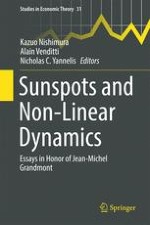2017 | OriginalPaper | Chapter
11. Can Consumption Taxes Stabilize the Economy in the Presence of Consumption Externalities?
Authors : Teresa Lloyd-Braga, Leonor Modesto
Published in: Sunspots and Non-Linear Dynamics
Publisher: Springer International Publishing
Activate our intelligent search to find suitable subject content or patents.
Select sections of text to find matching patents with Artificial Intelligence. powered by
Select sections of text to find additional relevant content using AI-assisted search. powered by
